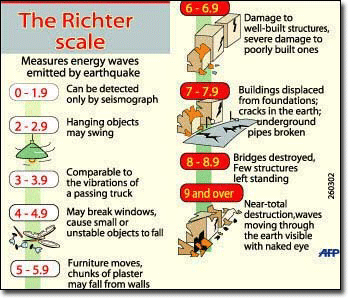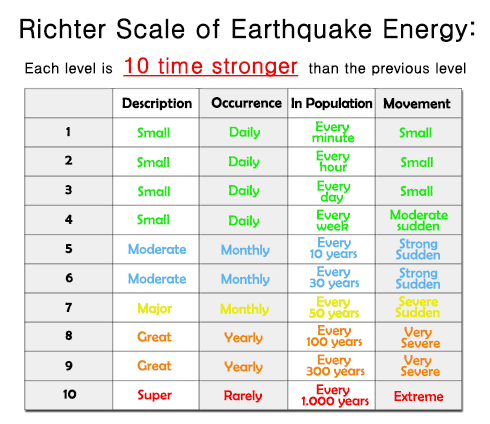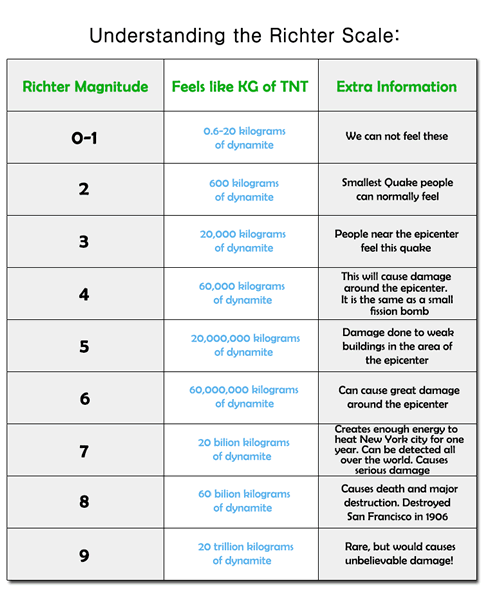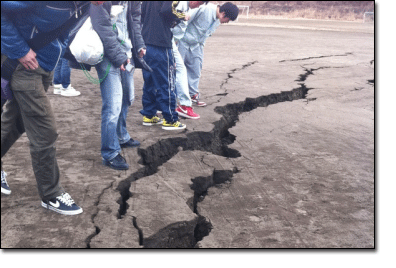
Richter Scale
What is the Richter Scale
The Richter magnitude scale (often shortened to Richter scale) is the most common standard of measurement for earthquakes. It was invented in 1935 by Charles F. Richter of the California Institute of Technology as a mathematical device to compare the size of earthquakes. The Richter scale is used to rate the magnitude of an earthquake, that is the amount of energy released during an earthquake.

The Richter scale doesn't measure quake damage (see: Mercalli Scale) which is dependent on a variety of factors including population at the epicentre, terrain, depth, etc. An earthquake in a densely populated area which results in many deaths and considerable damage may have the same magnitude as a shock in a remote area that does nothing more than frightening the wildlife. Large-magnitude earthquakes that occur beneath the oceans may not even be felt by humans.

The magnitude of an earthquake is determined using information gathered by a seismograph.
How is the Richter Scale calculated
The Richter magnitude involves measuring the amplitude (height) of the largest recorded wave at a specific distance from the seismic source. Adjustments are included for the variation in the distance between the various seismographs and the epicentre of the earthquakes.
The Richter scale is a base-10 logarithmic scale, meaning that each order of magnitude is 10 times more intensive than the last one. In other words, a two is 10 times more intense than a one and a three is 100 times greater. In the case of the Richter scale, the increase is in wave amplitude. That is, the wave amplitude in a level 6 earthquake is 10 times greater than in a level 5 earthquake, and the amplitude increases 100 times between a level 7 earthquake and a level 9 earthquake. The amount of energy released increases 31.7 times between whole number values.

In fact, it is to point out that, while it is correct to say that for each increase in 1 in the Richter magnitude there is a tenfold increase in amplitude of the wave, it is incorrect to say that each increase of 1 in Richter magnitude represents a tenfold increase in the size of the earthquake (as is commonly incorrectly stated by the press). A better measure of the size of an earthquake is the amount of energy released by the earthquake, which is related to the Richter Scale by the following equation: Log E = 11.8 + 1.5 M (where Log refers to the logarithm to the base 10, E is the energy released in ergs and M the Richter magnitude).
Richter Scale formula
This above principle is expressed by the original Richter Scale formula as:

At first, the Richter scale could be applied only to the records from instruments of identical manufacture. Now, instruments are carefully calibrated with respect to each other. Thus, magnitude can be computed from the record of any calibrated seismograph.
The Richter Scale has no upper limit. Recently, another scale called the moment magnitude scale MMS has been devised for more precise study of great earthquakes.
The Richter Scale Explained in a video
Highest magnitude ever recorded
Tectonic earthquakes can range in size from magnitudes less than zero, resulting from fault slippage of a few centimetres, to the largest events (magnitude greater than 9), where fault displacements are on the order of many metres. The size of an earthquake is not only a function of the amount of displacement but also the area of the fault plane that ruptures. Hence the larger the rupture area, the larger is the earthquake. A magnitude 7 earthquake ruptures a fault area of about 1000 km2 or about 50 km long and 20 km wide.
Also depth is an important factor influencing earthquake severity. We know that earthquakes can originate at various depths within the Earth's solid core. The deeper the earthquake, the more powerful it is, but it is also far less likely to reach the surface. That's why shallow earthquakes are more common and more dangerous, because the shallower an earthquake, the more damage to surface structures it can cause.
The largest earthquakes in historic times have been of magnitude slightly over 9, although there is no limit to the possible magnitude. The most recent large earthquake of magnitude 9.0 or larger was a 9.0 magnitude earthquake in Japan in 2011 (as of March 2011), and it was the largest Japanese earthquake since records began.

Fortunately most earthquakes are extremely small. A majority of quakes register less than 3 on the Richter scale; these tremors, called micro-earthquakes, aren't generally felt by people and are usually recorded only on local seismographs. With every whole point the magnitude rises, the strength of the waves increases tenfold. Events with magnitudes of about 4.5 or greater - there are several thousand such shocks annually - are strong enough to be recorded by sensitive seismographs all over the world. Only a tiny portion of earthquakes (15 or so of the 1.4 million quakes that register above 2.0) register at 7 or above, which is the threshold for a quake to be considered major.
A temblor with a magnitude of 8.0 or higher is considered a "great earthquake." On the average, one earthquake of such size, such as the 1964 Good Friday Earthquake in Alaska and the 2011 Japanese Earthquake and Tsunami, occurs somewhere in the world each year. The biggest quake in recorded history was the 9.5 quake that struck Chile in 1960. It killed nearly 1,900 people and caused about $4 billion in damage in 2010 dollars. Generally, you won't see much damage from earthquakes that register below 4 on the Richter scale.
For You and Your Loved Ones
With preparedness and safety measures, protect yourself and your family from earthquake risks.
Always good to prepare for an earthquake
Earthquake Warnings are a Game Changer
Stay protected, anytime, anywhere




